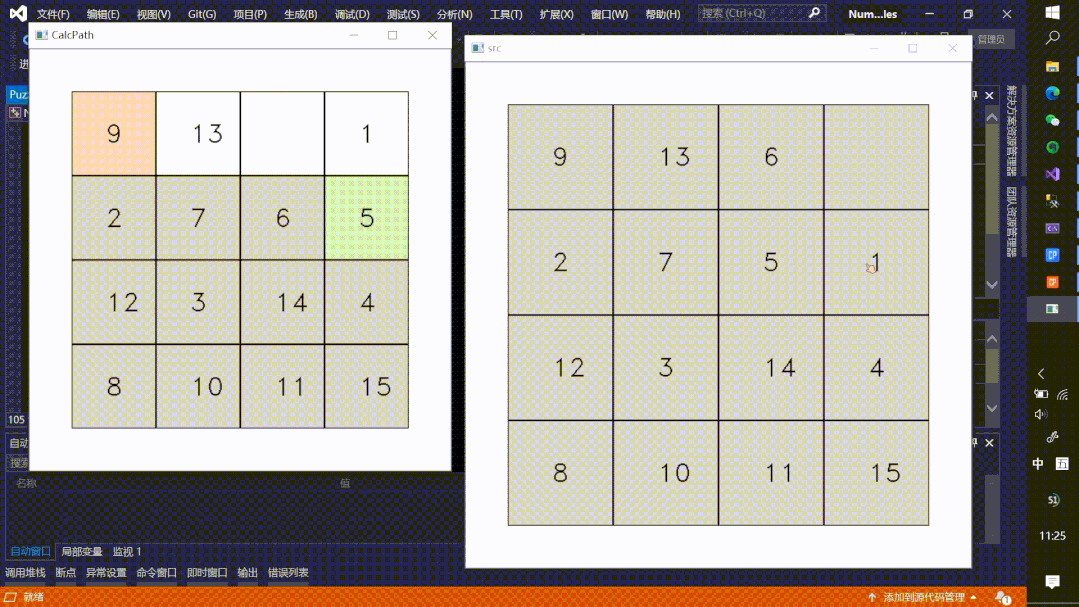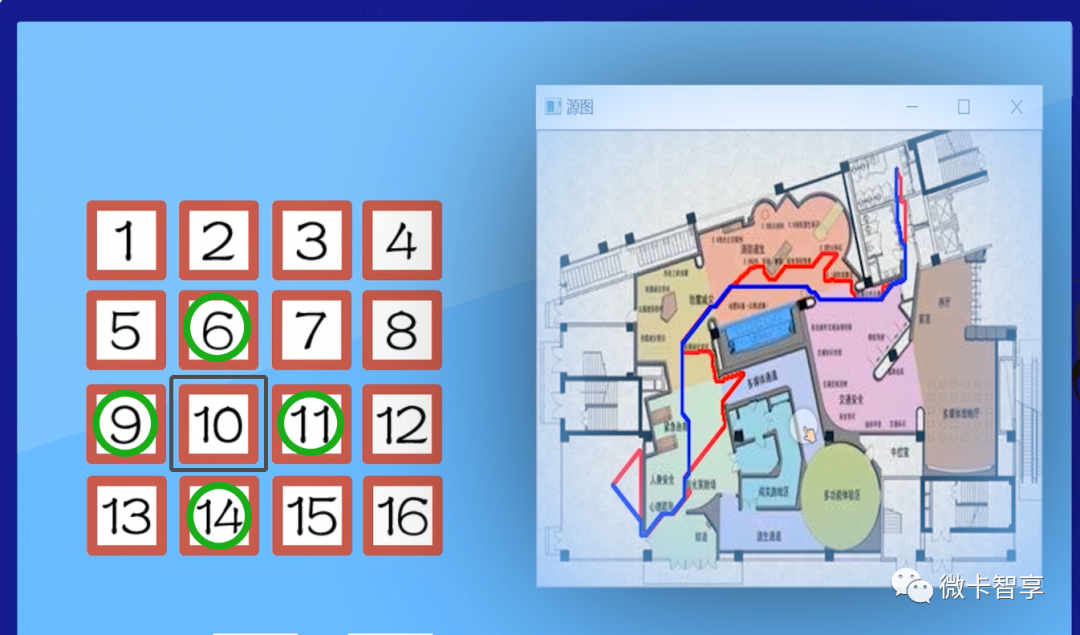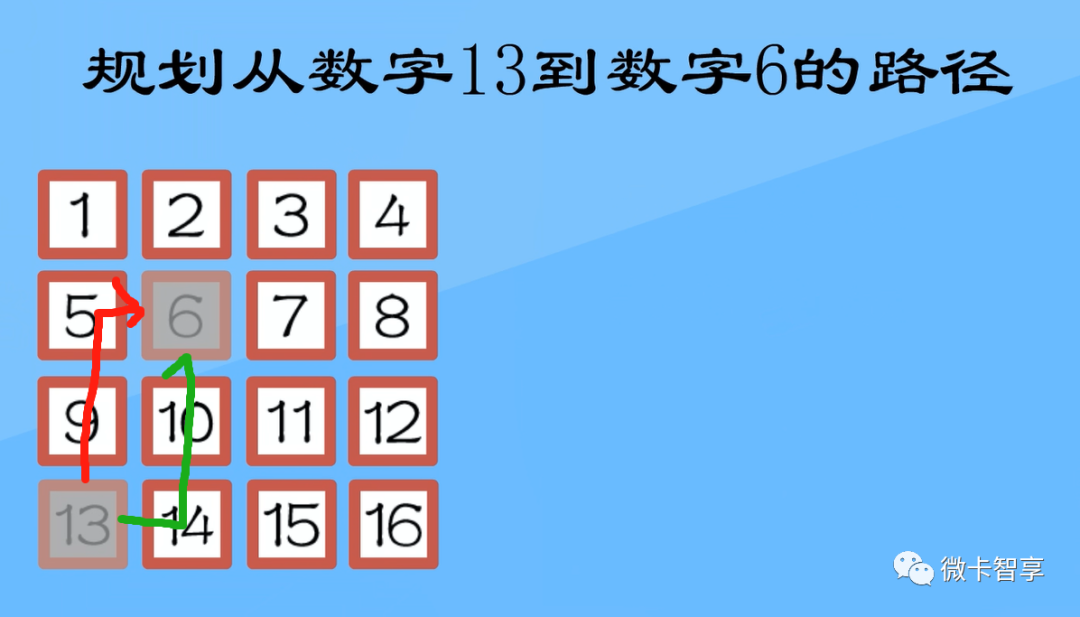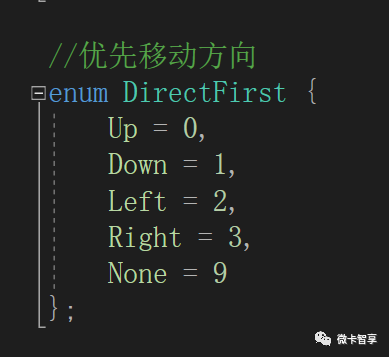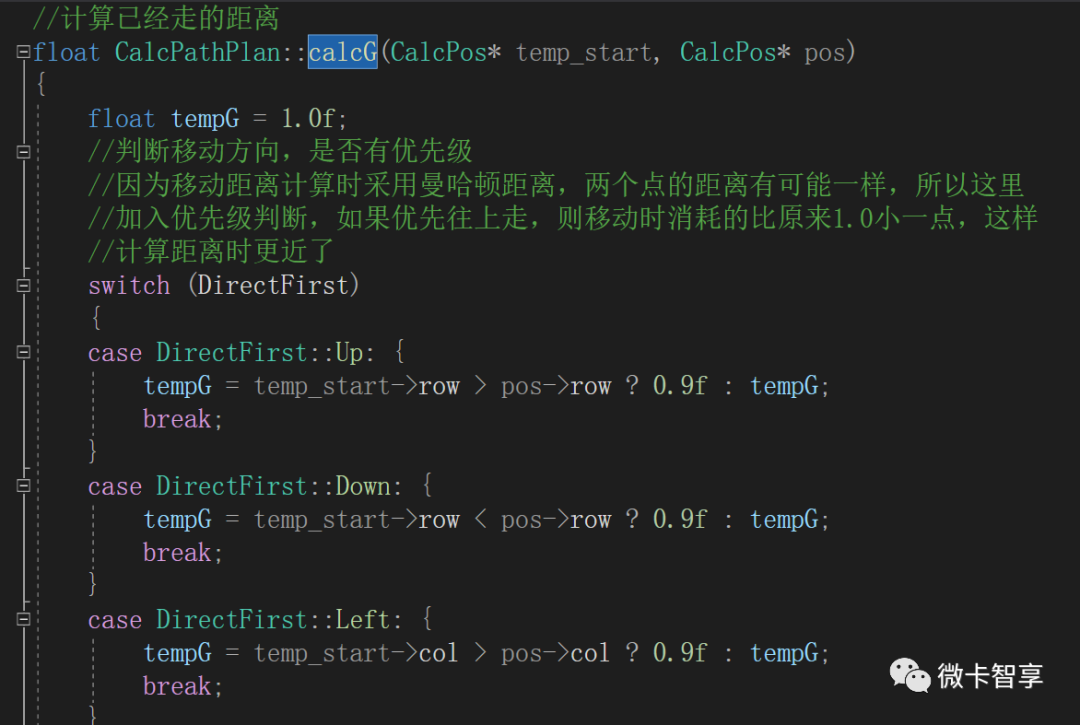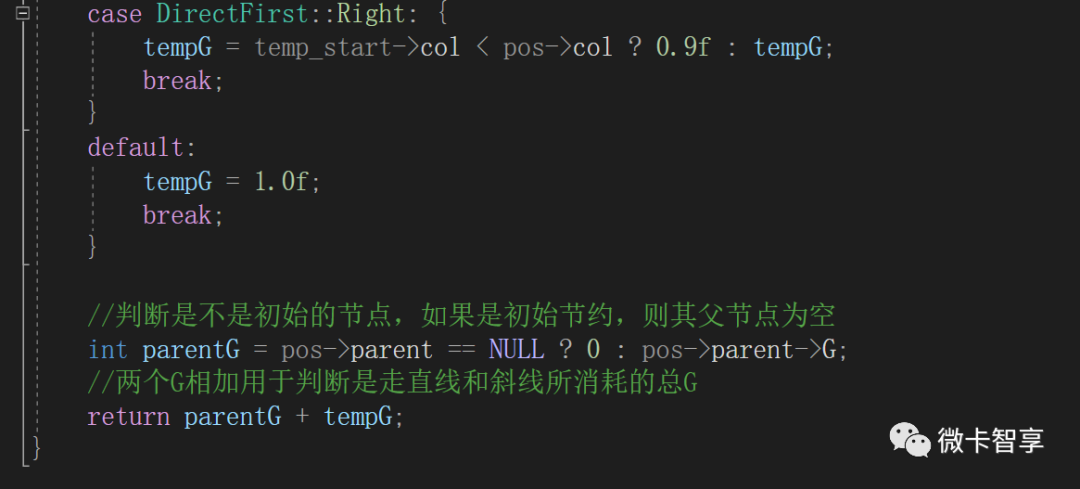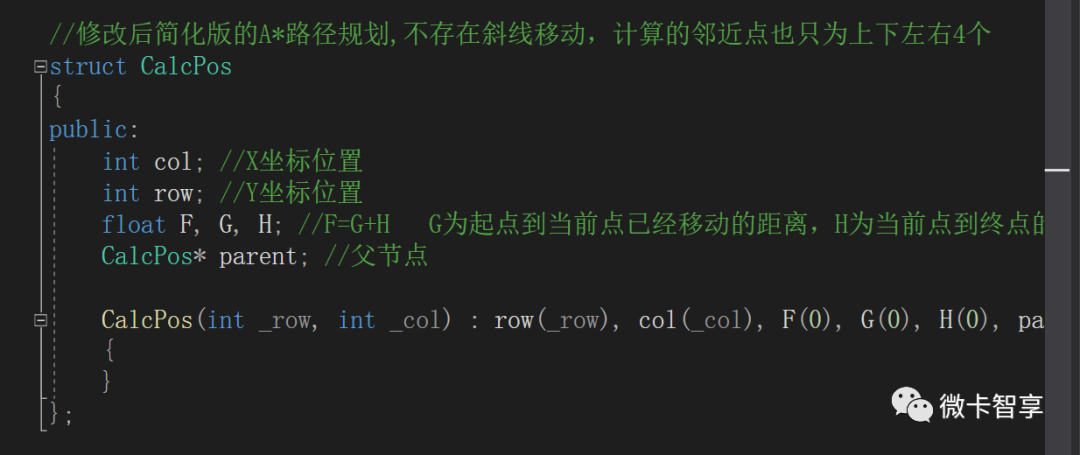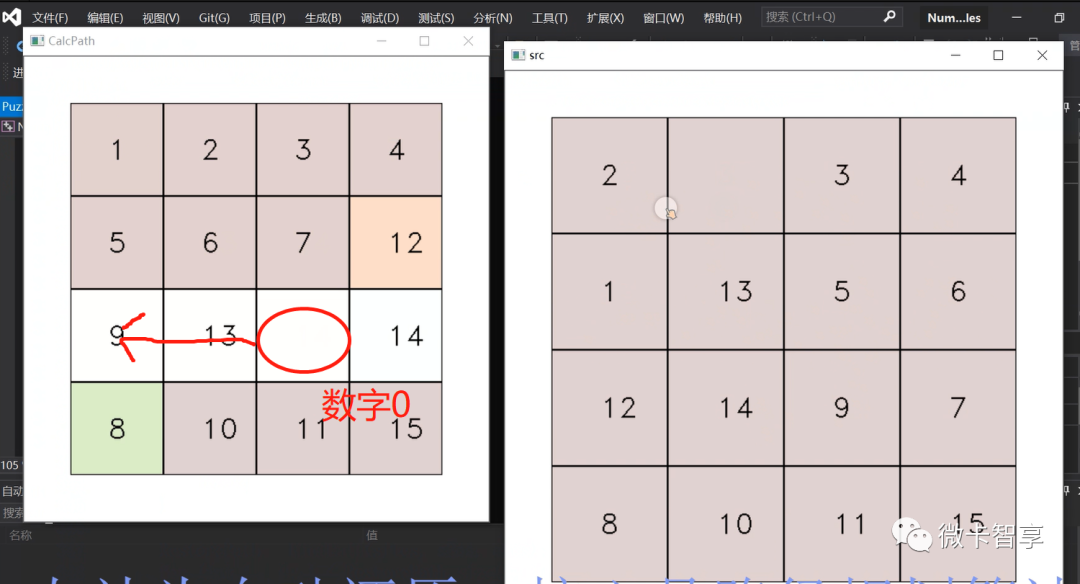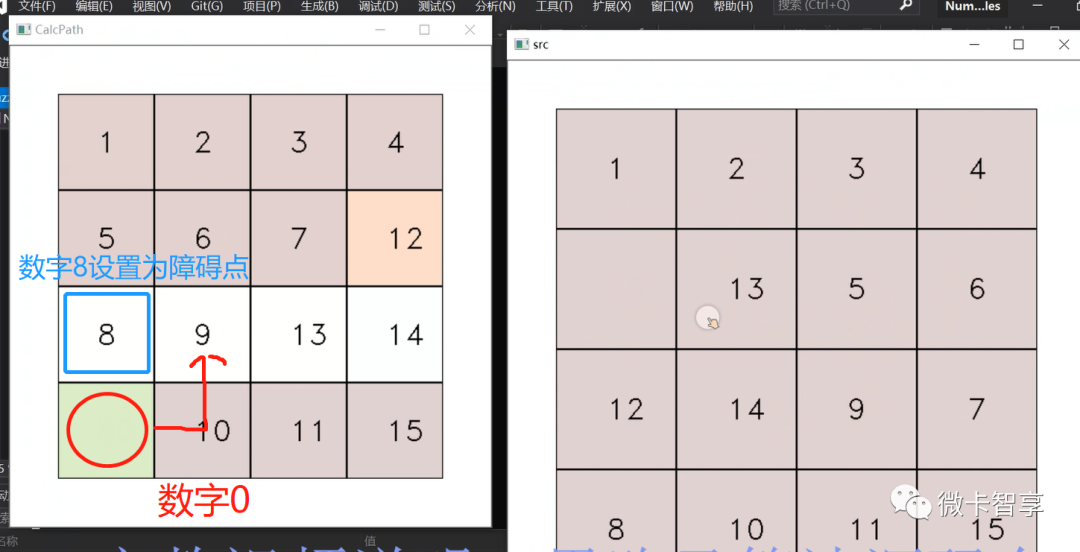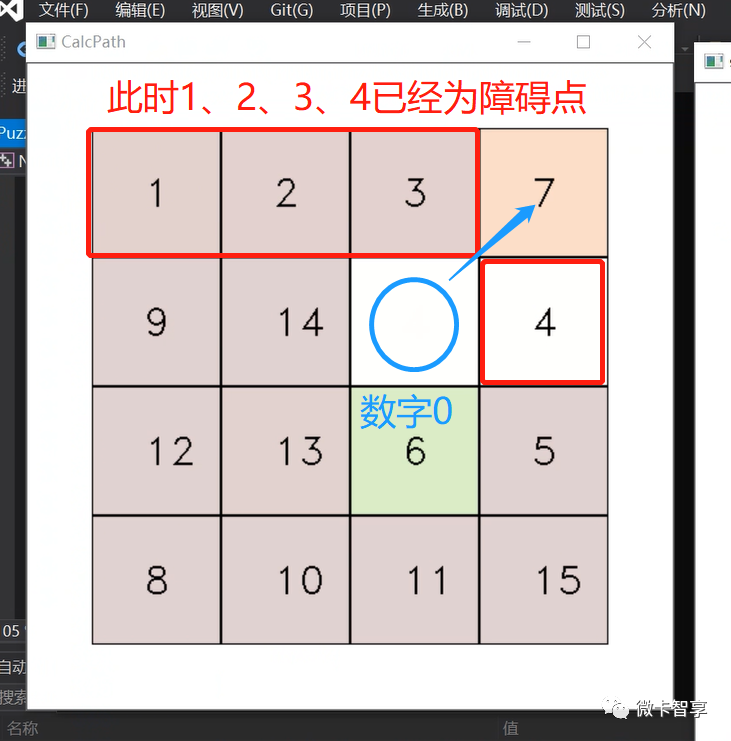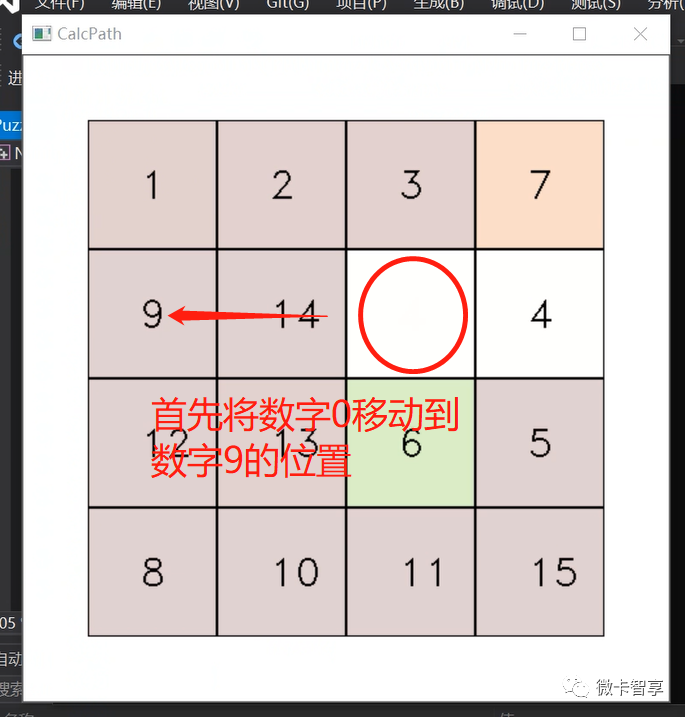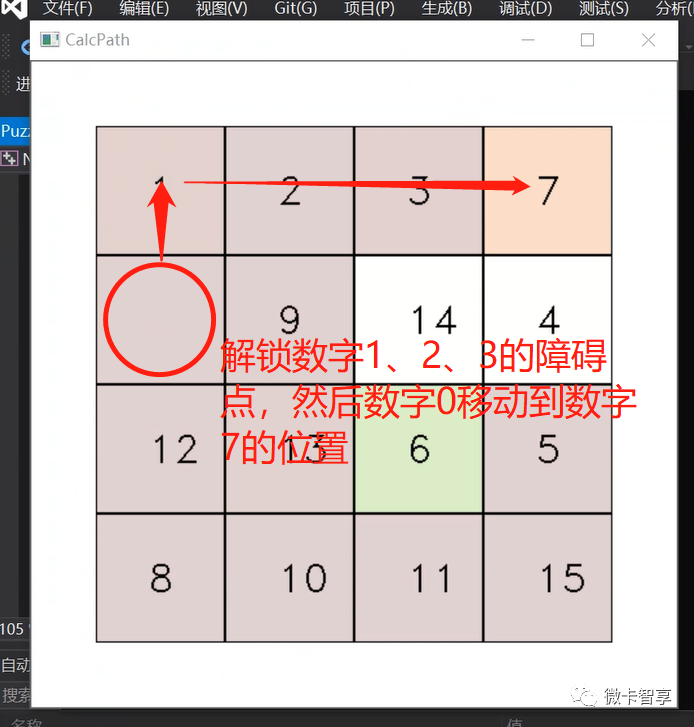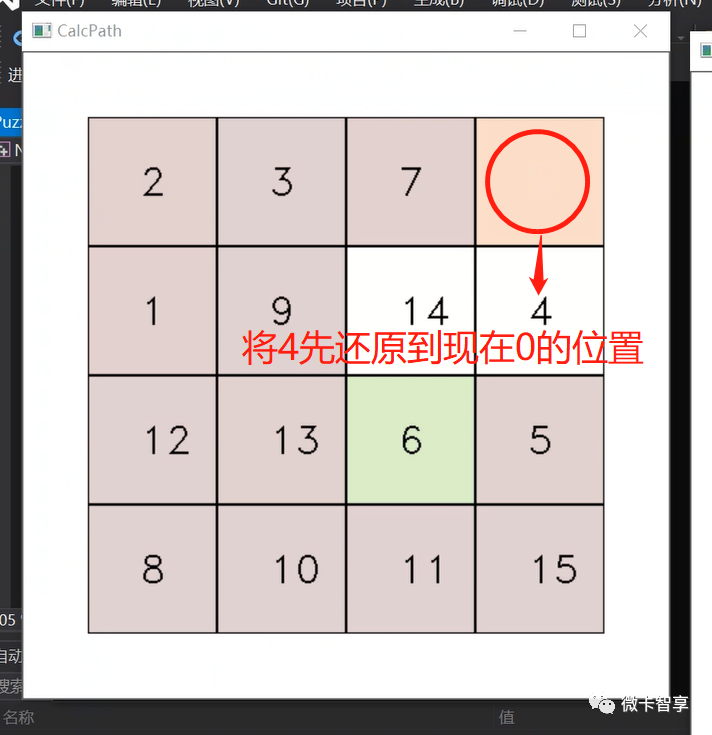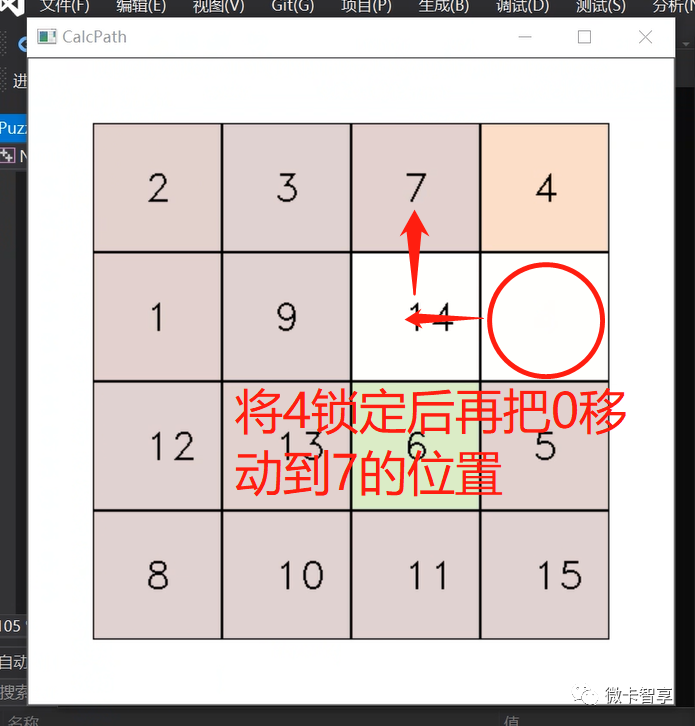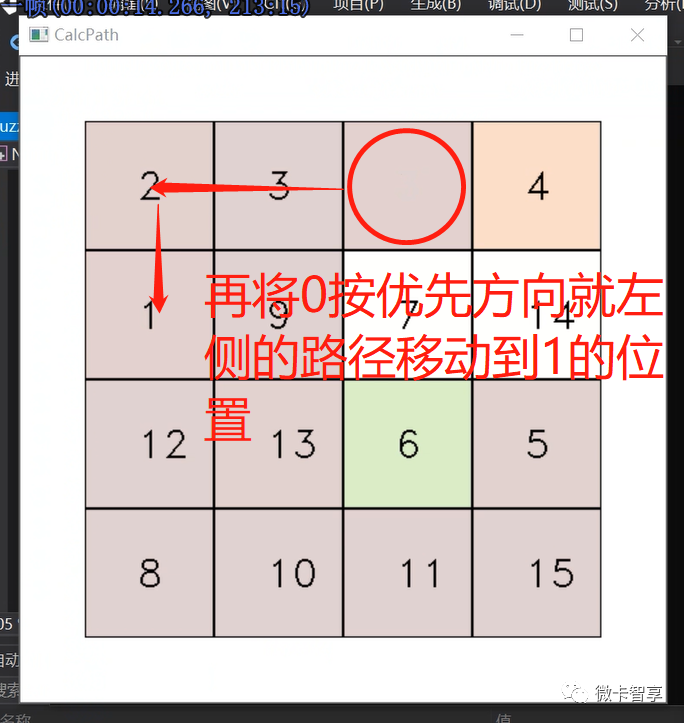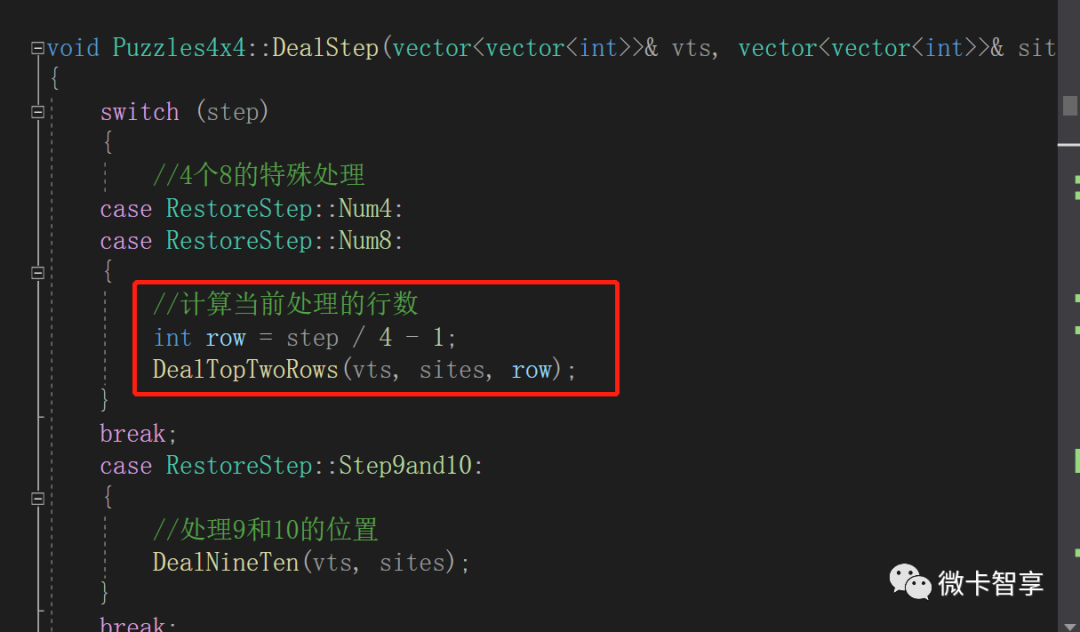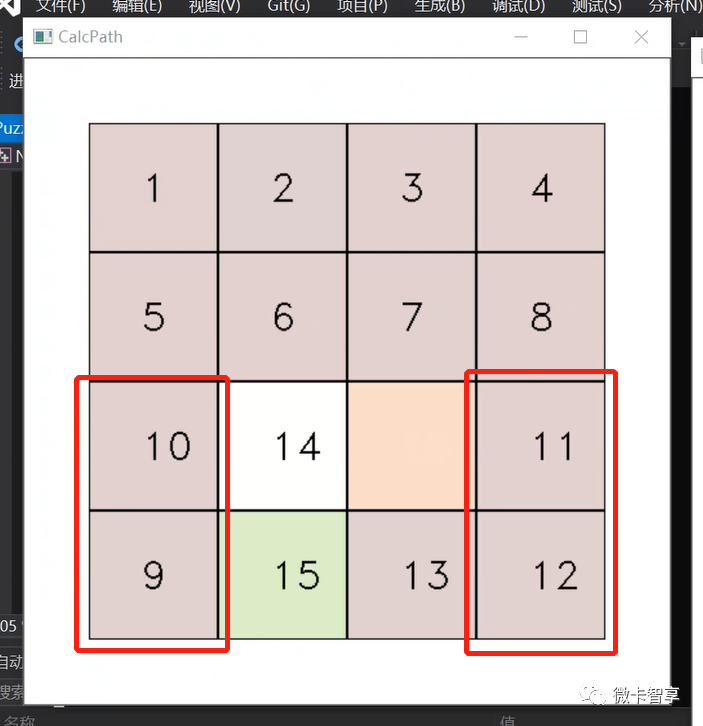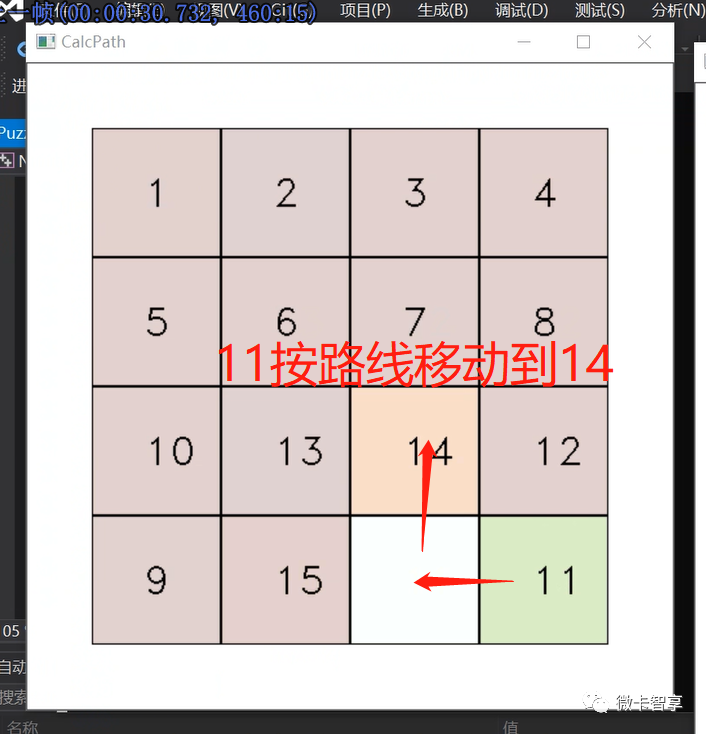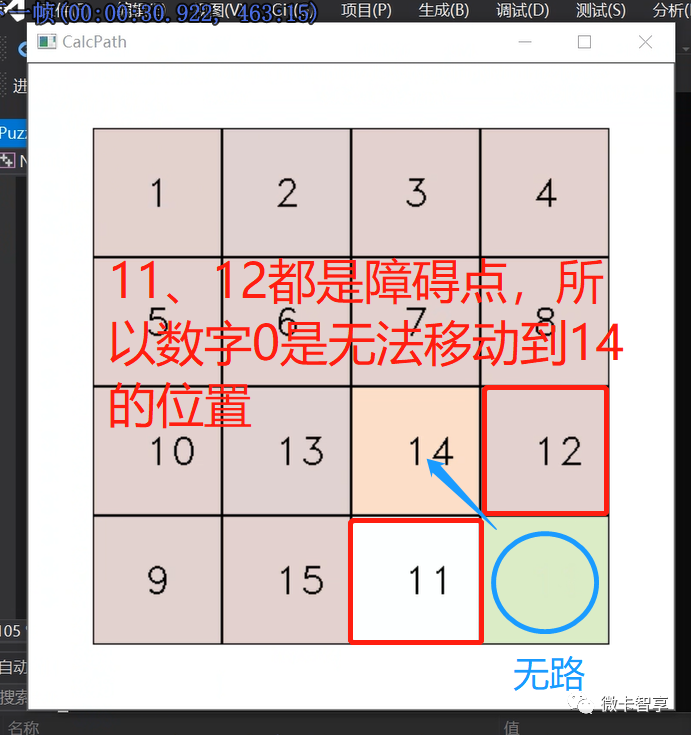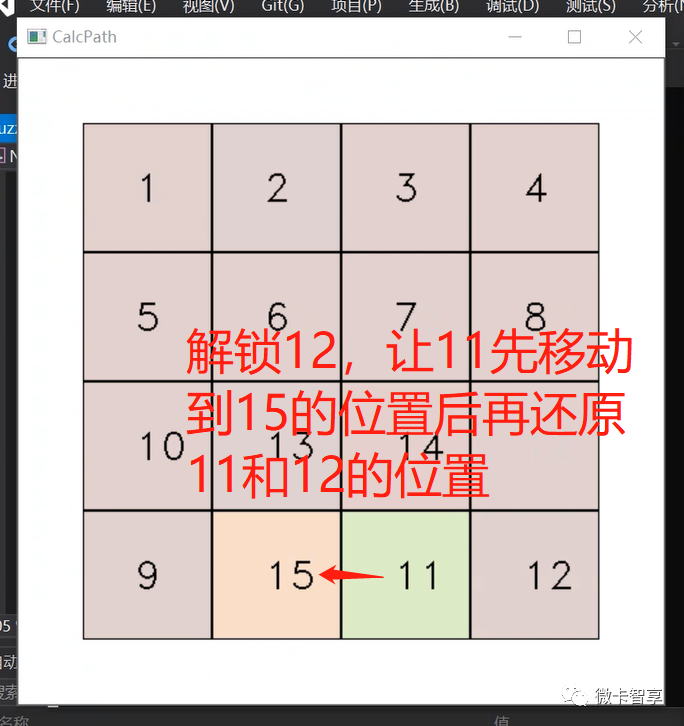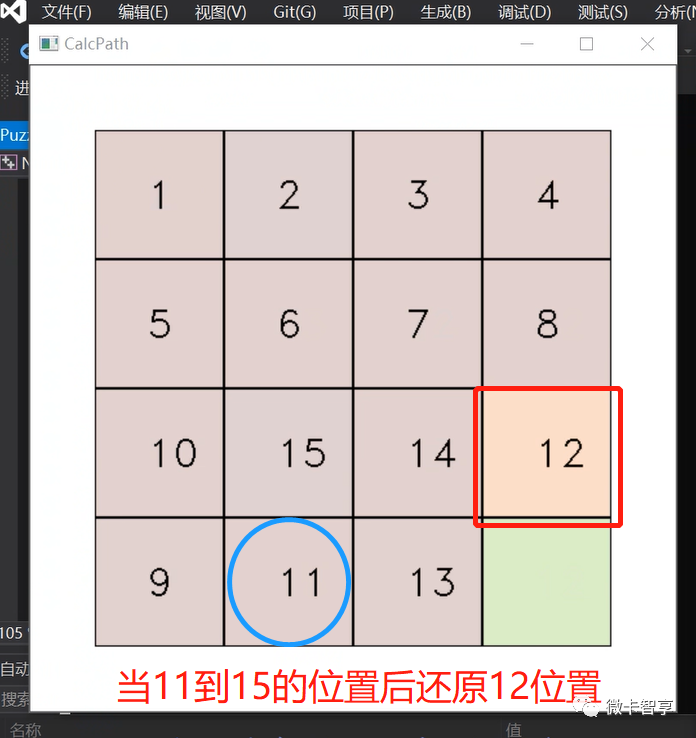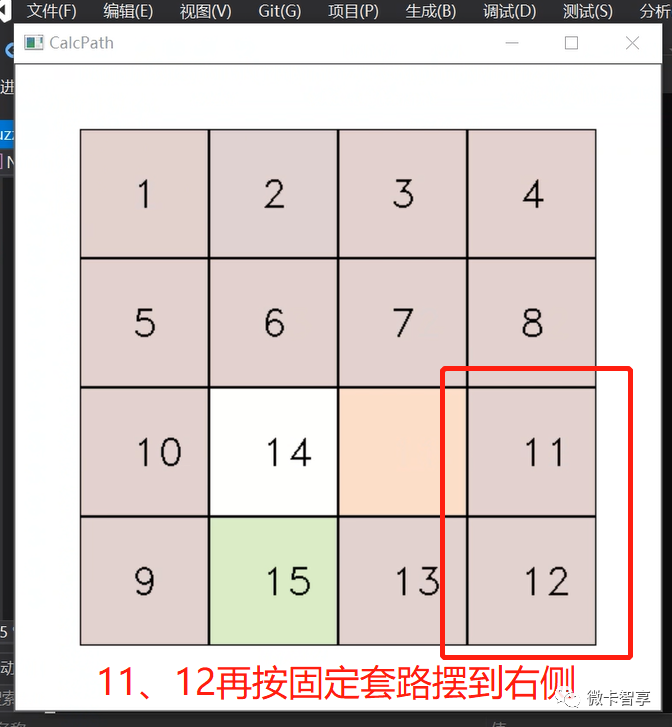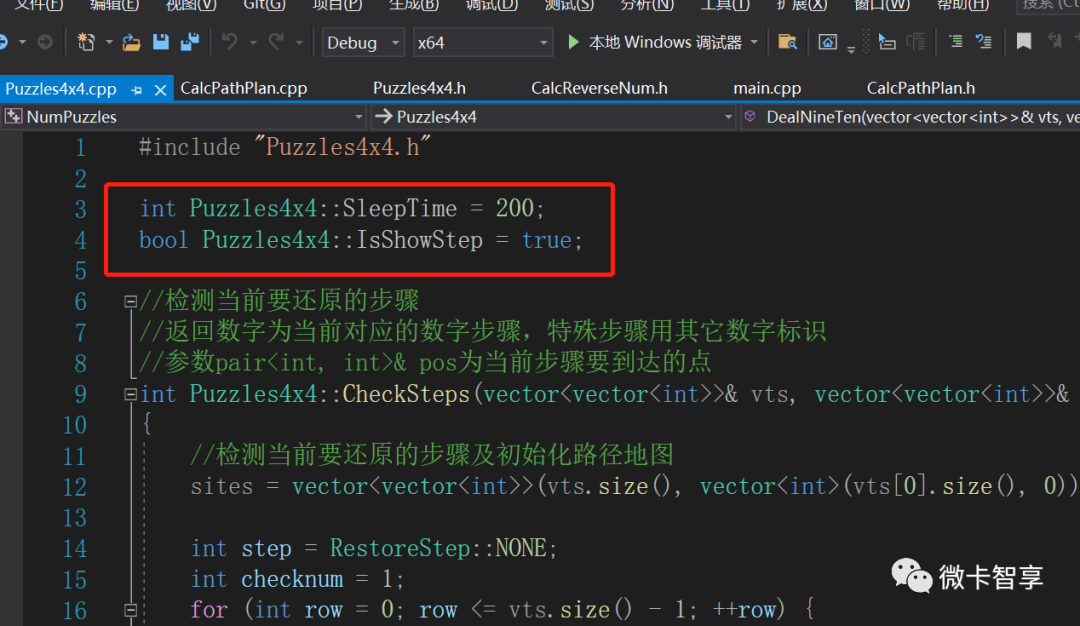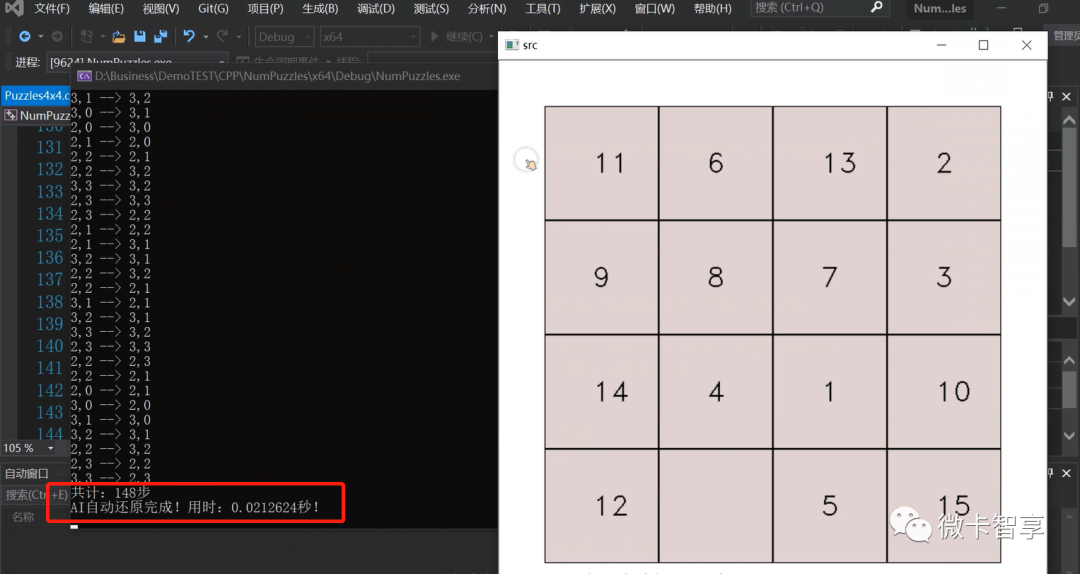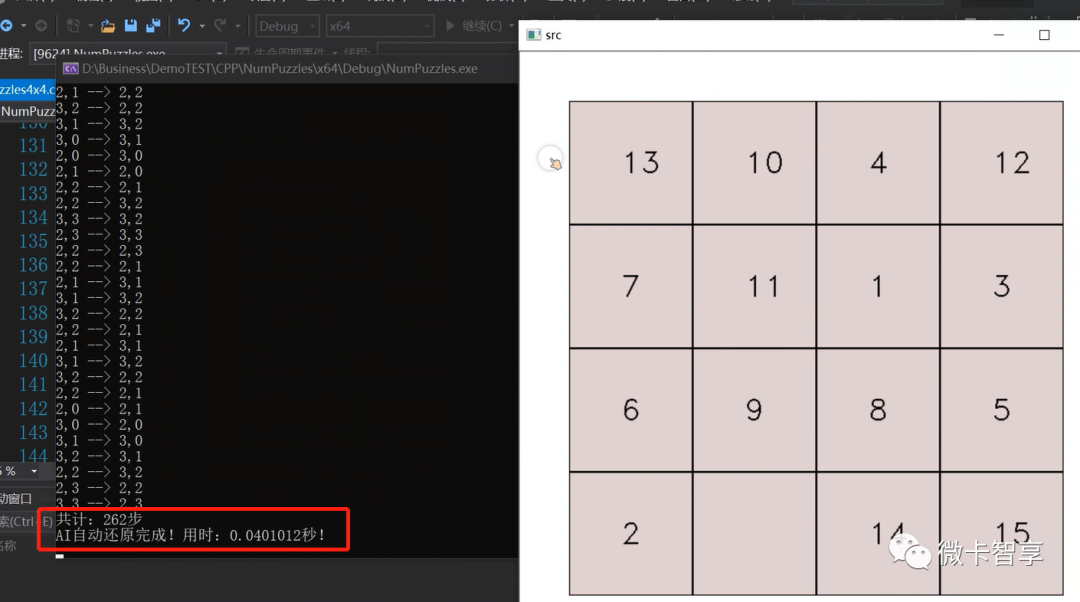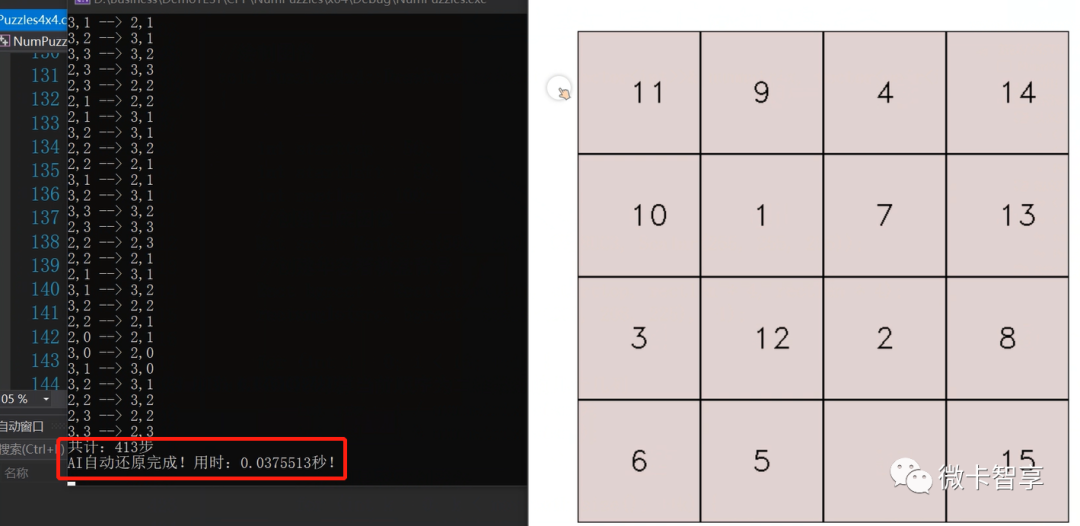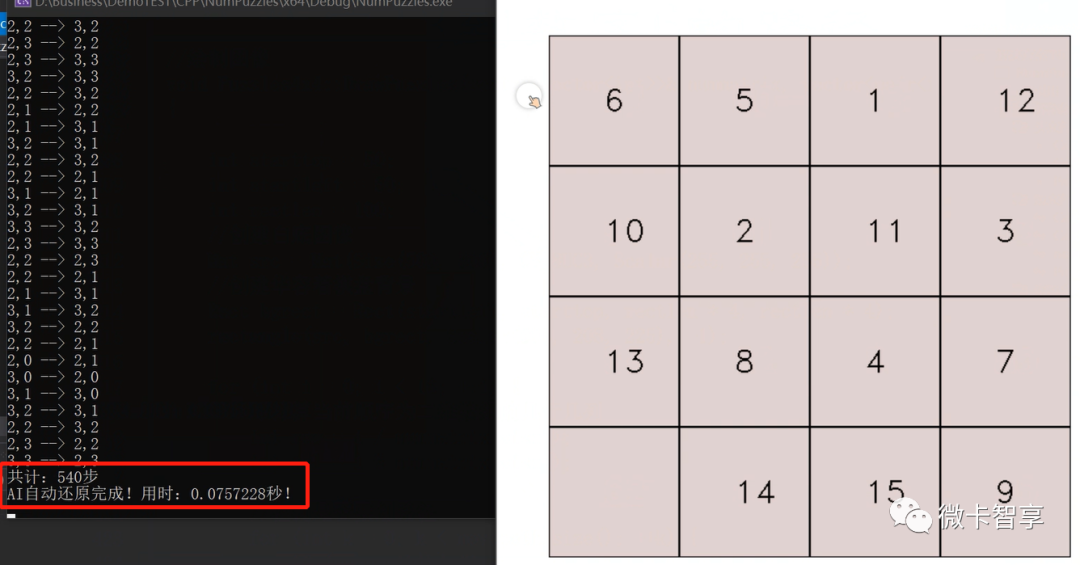学更好的别人,做更好的自己。——《微卡智享》
前言
上一期《整活!我是如何用OpenCV做了数字华容道游戏!(附源码)》实现数字华容道游戏的制作,相对来说也比较简单,所以本篇是在这个基础上我们提升一下难度,用代码来实现数字华容道的AI自动还原。
实现效果
完整的视频思路讲解可以点下面的视频进行观看。
趣玩算法–数字华容道AI自动解题
Q1
华容道自动还原的核心点?
想要用程序实现数字华容道的自动还原,需要掌握什么?
1.数字华容道的解题方法,这个网上教学有不少。
2.怎么用程序实现数字移动到指定位置。(核心就是路径规划算法)。
路径规划算法

微卡智享
数字华容道的路径规划算法是也是基于A星算法原理实现的,区别就是A星算法是允许斜线移动,在计算当前要规划的点时,需要计算周围8个邻近点,而数字华容道行动时不允许走斜线,所以只能计算上下左右四个直线方向的点。
图中计算当前要行动的点是数字10,数字华容道计算时只计算6、9、11、14,而A星算法除了上面4个还要计算5、7、13、15。
01
直线移动距离相等问题
也正是因为数字华容道只允许走直线,所以要计算的点离终点距离有可能会存在2个路径是相等的,怎么解决这个问题呢?
上图中13到6的移动,红色线路和绿色线路用的体力是一样的都是3
解决上图这个问题,算法里加入了优先移动方向的参数,如上图取出13邻居可移动的数字为9和14,默认13到9和14的用的体力都是1,如果设置优先移动方向为上,那就变为13到9的体力为0.9,而13到14的体力还是1,这样整个计算下来红色线路要比绿色线路节省体力,最终规划的线路就是红色线路。
优先移动方向枚举
计算消耗的体力,加入优先行动方向的区分
02
数据结构
路径规划中每取到一个到终点用的体力最少的点时,就用这个点继续开始往下查找,所以数据结构上用链表的方式,每个点都有其父节点,直接找到终点后通过终点的父节点一步步的反推到起点,即是我们的行动路径。
定义的数据结构
加入地图障碍、开户列表、关闭列表
定义了一个开启列表和一个关闭列表,其中开启列表中存放着还未计算的所有点,关闭列表中存放着已经计算过的点。每次从开启列表中取出到终点体力最少的点,都存放到关闭列表中,还有找出这个点的上下左右可移动的点,当这几个点中超过地图范围或是在障碍点中,以及已经在关闭列表中时,就不做为可移动的点了,这样可以减少循环的计算量。
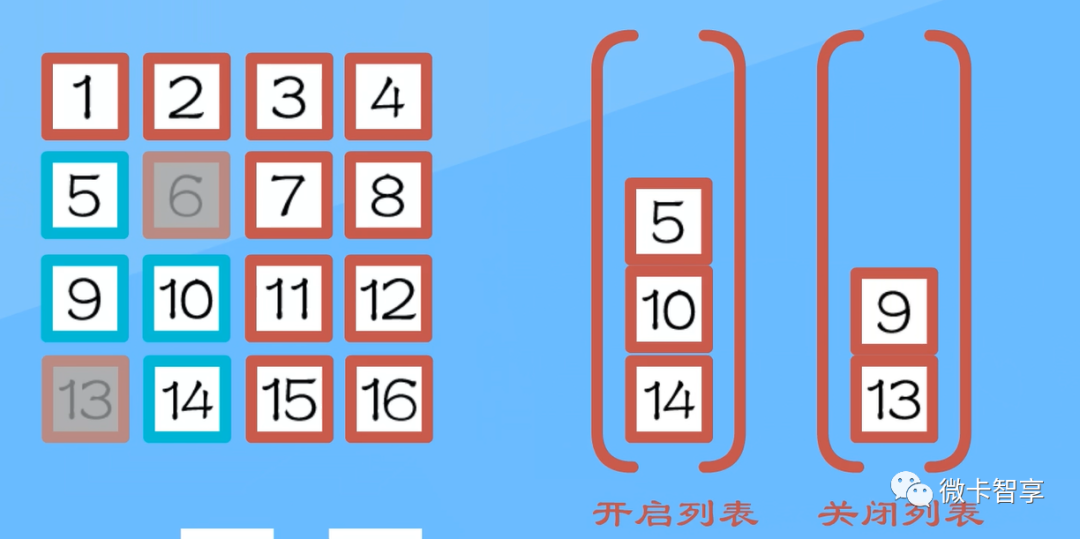
核心代码
CalcPathPlan.h
#pragma once
#include <iostream>
#include <vector>
#include <list>
using namespace std;
//修改后简化版的A*路径规划,不存在斜线移动,计算的邻近点也只为上下左右4个
struct CalcPos
{
public:
int col; //X坐标位置
int row; //Y坐标位置
float F, G, H; //F=G+H G为起点到当前点已经移动的距离,H为当前点到终点的距离
CalcPos* parent; //父节点
CalcPos(int _row, int _col) : row(_row), col(_col), F(0), G(0), H(0), parent(NULL)
{
}
};
//优先移动方向
enum DirectFirst {
Up = 0,
Down = 1,
Left = 2,
Right = 3,
None = 9
};
class CalcPathPlan
{
private:
CalcPos* findPath(CalcPos& startPos, CalcPos& endPos);
//计算临近的上下左右4个点
vector<CalcPos*> getSurroundPos(const CalcPos* pos);
//判断当前的点是否可以列入计算列表
bool isCanCalc(const CalcPos* pos, const CalcPos* target);
//判断点是否在开启或是关闭列表中
CalcPos* isInList(const list<CalcPos*>& list, const CalcPos* pos);
//检测障碍点
bool isInSites(const int row, const int col) const;
//从开启列表中返回F值最小的节点
CalcPos* getLeastFpoint();
//计算FGH值
float calcG(CalcPos* temp_start, CalcPos* pos);
float calcH(CalcPos* pos, CalcPos* end);
float calcF(CalcPos* pos);
vector<vector<int>> sites; //华容道棋盘 0-可通行,1-障碍点
list<CalcPos*> openList; //开启列表
list<CalcPos*> closeList; //关闭列表
public:
//参数优先移动方向
int DirectFirst = DirectFirst::Up;
//初始化地图
void InitSites(vector<vector<int>> _sites);
//获取到路径
vector<pair<int,int>> GetPath(pair<int, int>& startPos, pair<int, int>& endPos);
};
CalcPathPlan.cpp
#include "CalcPathPlan.h"
CalcPos* CalcPathPlan::findPath(CalcPos& startPos, CalcPos& endPos)
{
//首先写入起点,拷贝开启一个节点,内外隔离
CalcPos* firstpt = new CalcPos(startPos.row, startPos.col);
firstpt->H = calcH(firstpt, &endPos);
firstpt->F = calcF(firstpt);
openList.push_front(firstpt);
while (!openList.empty()) {
//找到F值最小的点
auto curPoint = getLeastFpoint();
//从开启列表中删除
openList.remove(curPoint);
//存放到关闭列表中
closeList.push_front(curPoint);
//1.找到当前点周围四个点中可以通过的点
auto surroundPos = getSurroundPos(curPoint);
for (auto& target : surroundPos) {
//2.对某一个点,如果不在开启列表中,加入到开启列表中,设置当前格为父节点,计算F,G,H的值
CalcPos* targetpos = isInList(openList, target);
if (!targetpos) {
//计算F,G,H的值
target->G = calcG(curPoint, target);
target->H = calcH(target, &endPos);
target->F = calcF(target);
target->parent = curPoint;
//插入到开启列表中
openList.push_front(target);
}
//3.对某个点在开启列表中计算G值,如果比原来的大,就什么都不做
//否则设置它的父节点为当前点,并更新G和F
else {
int tempG = calcG(curPoint, targetpos);
if (tempG < targetpos->G) {
targetpos->parent = curPoint;
targetpos->G = tempG;
targetpos->F = calcF(targetpos);
}
}
CalcPos* resPoint = isInList(openList, &endPos);
//返回列表里的节点指针,不要用原来传入的endpoint指针,因为发生了深拷贝
if (resPoint)
return resPoint;
}
}
return NULL;
}
//计算当前点的可移动的上下左右点
vector<CalcPos*> CalcPathPlan::getSurroundPos(const CalcPos* pos)
{
vector<CalcPos*> surroundPos;
//上方点
if (isCanCalc(pos, new CalcPos(pos->row - 1, pos->col))) {
surroundPos.push_back(new CalcPos(pos->row - 1, pos->col));
}
//下方点
if (isCanCalc(pos, new CalcPos(pos->row + 1, pos->col))) {
surroundPos.push_back(new CalcPos(pos->row + 1, pos->col));
}
//左方点
if (isCanCalc(pos, new CalcPos(pos->row, pos->col - 1))) {
surroundPos.push_back(new CalcPos(pos->row, pos->col - 1));
}
//右方点
if (isCanCalc(pos, new CalcPos(pos->row, pos->col + 1))) {
surroundPos.push_back(new CalcPos(pos->row, pos->col + 1));
}
return surroundPos;
}
bool CalcPathPlan::isCanCalc(const CalcPos* pos, const CalcPos* target)
{
//坐标小于0直接不计算了
if (target->col < 0 || target->row < 0
//计算的点与当前一致也不计算
|| (target->col == pos->col && target->row == pos->row)
//判断点在障碍点中不计算
|| isInSites(target->row, target->col)
//如果点在关闭列表中也不计算
|| isInList(closeList, target))
return false;
else {
return true;
}
}
//判断开启/关闭列表中是否包含某点
CalcPos* CalcPathPlan::isInList(const list<CalcPos*>& list, const CalcPos* pos)
{
//判断某个节点是否在列表中,这里不能比较指针,因为每次加入列表是新开辟的节点,只能比较坐标
for (auto p : list)
if (p->col == pos->col && p->row == pos->row)
return p;
return NULL;
}
bool CalcPathPlan::isInSites(const int row, const int col) const
{
if (col < 0 || row < 0 || row >= sites.size()
|| col >= sites[0].size()) return true;
return sites[row][col] == 1;
}
//获取开启列表中F值最小的点才行动计算点
CalcPos* CalcPathPlan::getLeastFpoint()
{
if (!openList.empty())
{
auto resPos = openList.front();
for (auto& pos : openList)
if (pos->F < resPos->F)
resPos = pos;
return resPos;
}
return NULL;
}
//计算已经走的距离
float CalcPathPlan::calcG(CalcPos* temp_start, CalcPos* pos)
{
float tempG = 1.0f;
//判断移动方向,是否有优先级
//因为移动距离计算时采用曼哈顿距离,两个点的距离有可能一样,所以这里
//加入优先级判断,如果优先往上走,则移动时消耗的比原来1.0小一点,这样
//计算距离时更近了
switch (DirectFirst)
{
case DirectFirst::Up: {
tempG = temp_start->row > pos->row ? 0.9f : tempG;
break;
}
case DirectFirst::Down: {
tempG = temp_start->row < pos->row ? 0.9f : tempG;
break;
}
case DirectFirst::Left: {
tempG = temp_start->col > pos->col ? 0.9f : tempG;
break;
}
case DirectFirst::Right: {
tempG = temp_start->col < pos->col ? 0.9f : tempG;
break;
}
default:
tempG = 1.0f;
break;
}
//判断是不是初始的节点,如果是初始节约,则其父节点为空
int parentG = pos->parent == NULL ? 0 : pos->parent->G;
//两个G相加用于判断是走直线和斜线所消耗的总G
return parentG + tempG;
}
float CalcPathPlan::calcH(CalcPos* pos, CalcPos* end)
{
//计算终点到当前点的距离,因为不用斜着走,所以采用曼哈顿距离计算
return abs(end->col - pos->col) + abs(end->row - pos->row);
}
float CalcPathPlan::calcF(CalcPos* pos)
{
//公式 F=G+H
return pos->F = pos->G + pos->H;
}
//初始化地图
void CalcPathPlan::InitSites(vector<vector<int>> _sites)
{
sites = _sites;
}
vector<pair<int, int>> CalcPathPlan::GetPath(pair<int, int>& startPos, pair<int, int>& endPos)
{
CalcPos sPos = CalcPos(startPos.first, startPos.second);
CalcPos ePos = CalcPos(endPos.first, endPos.second);
CalcPos* result = findPath(sPos, ePos);
vector<pair<int, int>> path;
//返回路径,如果没有找到路径,返回空链表
while (result) {
pair<int, int> curpath(result->row, result->col);
path.insert(path.begin(), curpath);
result = result->parent;
}
return path;
}
华容道代码编写

微卡智享
01
根据规划路径怎么移动
从上图中可以看到,通过路径规划已经计算出还原数字8的行动路径了,需要实现8在这个行动路径上移动,最终就是要把数字0(也就是空白格)移动到8的下一步行动格上(即现在9的位置),移动时就是根据当前格与到移动的格进行数字互换即可。
当移动完后0和数字8再进行位置交换,继续刚才的步骤,0再移动到数字9的位置,这时8再设置成为障碍点,这样规划0到9的位置时不会经过数字8(上一步也这样处理),等移动到位置后再把障碍点取消进行互换。
数字0移动的核心代码
int Puzzles4x4::ZeroMove(vector<vector<int>>& vts, vector<vector<int>>& sites, pair<int, int>& endPos, int MoveDirect)
{
pair<int, int> ZeroPos = GetPos(vts, 0);
vector<pair<int, int>> zeropath;
if (ZeroPos.first == endPos.first && ZeroPos.second == endPos.second) {
return 0;
}
zeropath = FindPath(sites, ZeroPos, endPos, MoveDirect);
//3.3.1 开始移动0到当前位置,从第一步开始,因为起点不动
for (int k = 1; k < zeropath.size(); ++k) {
//cout << "zeropath:" << zeropath[k].first << " " << zeropath[k].second << endl;
//当前位置与前一位置与换
SwapPos(vts, zeropath[k], zeropath[k - 1]);
}
return zeropath.size();
}
//两个点交换位置
void Puzzles4x4::SwapPos(vector<vector<int>>& vts, pair<int, int>& firstPos, pair<int, int>& secondPos)
{
//插入还原步骤
pair<pair<int, int>, pair<int, int>> curstep(firstPos, secondPos);
VetRestoreSteps.push_back(curstep);
int tmpnum = vts[firstPos.first][firstPos.second];
vts[firstPos.first][firstPos.second] = vts[secondPos.first][secondPos.second];
vts[secondPos.first][secondPos.second] = tmpnum;
}
02
华容道中特殊步骤处理
第一、二行最右侧处理
数字0无法移动到数字7的位置
上图中可以看出,数字4按路径规划移动到第二行第四格时,按我们定义的规则,现在数字4已经设置为障碍点了,同时因为数字1、2、3已经归位,所以也设置为障碍点,此时数字0移动到数字7是无路可走的,这里就需要进入到特殊步骤的环节了。
首先将数字0移动到数字9的位置
然后数字0移动到数字7的位置
按上面的方法,首先把数字1、2、3解锁障碍点,然后将数字0移动到数字7的位置,这里就可以体现到路径规划中加入方向参数的作用了,优先按向上行走,走的路线肯定是上图中的方案。
0到达位置后和4进行互换
重新移动0的位置到7
将0按优先左移的路径规划移动到1的位置,这样数字1、2、3就可以正常还原回去了
按上面的流程就处理好数字4了,数字8的原理和4是一样的,所以代码中我们写了一个方法,只是在开始判断当前处理的是第几行即可。
核心函数
void Puzzles4x4::DealTopTwoRows(vector<vector<int>>& vts, vector<vector<int>>& sites, int row)
{
//1.先将0移动到当前要处理的行的下面格
pair<int, int> endPos(row + 1, 0);
ZeroMove(vts, sites, endPos, DirectFirst::Left);
//2.解锁处理行前面的障碍点,用0的位置优先移动到计算点
for (int i = 0; i < sites[row].size(); ++i) {
sites[row][i] = 0;
}
endPos.first = row;
endPos.second = 2;
ZeroMove(vts, sites, endPos, DirectFirst::Up);
//3.数字0再和当前要处理的点进行位置互换,将我们4或8位置移动到对应后锁定
endPos.first = row + 1;
endPos.second = 3;
//防止移动点是锁定的,将改为可移动
sites[endPos.first][endPos.second] = 0;
ZeroMove(vts, sites, endPos, DirectFirst::Right);
//设置为锁定障碍点
sites[row][3] = 1;
//4.将数字0移动到第二步位置后还原当前行前三个数字
endPos.first = row;
endPos.second = 2;
ZeroMove(vts, sites, endPos);
//5.将0优先按左移的方式把原来行前面的数字还原回来
endPos.first = row + 1;
endPos.second = 0;
ZeroMove(vts, sites, endPos, DirectFirst::Left);
}
调用时的处理
第三和、四行处理
三、四行把9和10、11和12移动到两侧后,即可实现还原
第三和第四行要一起处理,基本都是按上图上的方法将9和10,还有11和12移动到两侧,然后把13–15移动好后统一还原即可。这两天基本就是固定套路,不过在还原(9,10)或是(11,12)时,有机率会出现下面的情况:
移动一步后
当遇到上面这种情况时,也算进入了异常处理,需要将12的障碍点先解锁,然后让11先移动到15的位置(因为在右下四个小格中,无论怎么转也不会出现我们要还源的11在12的上面这样情况)
按上面的步骤,就可以把11和12的位置按到最右侧了,同理,9和10在排到左侧时有机率也会出现这样的情况,处理的方式和上面的是一样的。
处理异常函数
//处理11和12的异常
void Puzzles4x4::DealElevenTwelve(vector<vector<int>>& vts, vector<vector<int>>& sites)
{
if ((vts[2][3] == 12) && (vts[2][2] = 11)) {
//1.锁定11个12当前位置,然后将0移动到右下角
sites[2][2] = 1;
sites[2][3] = 1;
pair<int, int> endPos(3, 3);
ZeroMove(vts, sites, endPos, DirectFirst::Right);
//2.解锁11个12的位置,将0移动到第三行第三个
sites[2][2] = 0;
sites[2][3] = 0;
endPos.first = 2;
endPos.second = 2;
ZeroMove(vts, sites, endPos, DirectFirst::Up);
}
}
//处理9和10的异常
void Puzzles4x4::DealNineTen(vector<vector<int>>& vts, vector<vector<int>>& sites)
{
if ((vts[2][0] == 9) && (vts[2][1] = 10)) {
//1.锁定9个10当前位置,然后将0移动到左下角
sites[2][0] = 1;
sites[2][1] = 1;
pair<int, int> endPos(3, 0);
ZeroMove(vts, sites, endPos, DirectFirst::Left);
//2.解锁9个10的位置,将0移动到第三行第二个
sites[2][0] = 0;
sites[2][1] = 0;
endPos.first = 2;
endPos.second = 1;
ZeroMove(vts, sites, endPos, DirectFirst::Up);
}
}
最后就是所以有数字都还原的固定走法了,感兴趣的朋友可以下载源码查看,这里就不再列出来了。
03
还原总的处理时间
为了大家观看实现的方式,视频中我加入了展示移动效果,并在每一步显示后加入了200毫秒延时。
上图中IsShowStep的值为true,现在把它改为false后,关闭图像展示,经过多次测试,平均还原的速度在0.05秒内,速度还是挺快的。
华容道AI自动还原的方法就讲到这里了,最后来放一下源码地址。
源码地址
https://github.com/Vaccae/OpenCVNumPuzzles.git
GitHub上不去的朋友,可以击下方的原文链接跳转到码云的地址,关注【微卡智享】公众号,回复【源码】可以下载我的所有开源项目。
完
扫描二维码
获取更多精彩
微卡智享
「 往期文章 」
整活!我是如何用OpenCV做了数字华容道游戏!(附源码)
C++ OpenCV去燥函数fastNlMeansDenoising的使用
C++ OpenCV实现图像去阴影
今天的文章趣玩算法–OpenCV华容道AI自动解题分享到此就结束了,感谢您的阅读。
版权声明:本文内容由互联网用户自发贡献,该文观点仅代表作者本人。本站仅提供信息存储空间服务,不拥有所有权,不承担相关法律责任。如发现本站有涉嫌侵权/违法违规的内容, 请发送邮件至 举报,一经查实,本站将立刻删除。
如需转载请保留出处:https://bianchenghao.cn/67267.html

